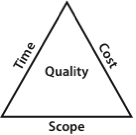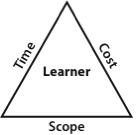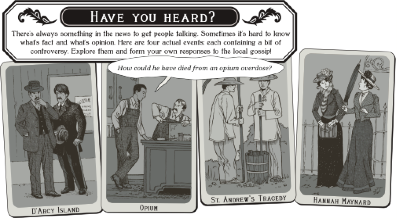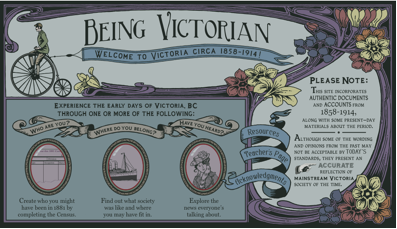
VOL. 24, No. 1, 43 - 54
An e-learning project is a balance of time, cost, and scope measured against learner engagement. With this measure, the learner is part of every stage in the project's development. Assessing decisions with regards to learner impact will contribute to a more engaging and therefore successful project. To illustrate this concept, this paper will detail the learner's place in each stage of a recent
e-learning project.
Un projet d’apprentissage en ligne est une équation de temps, de coût et d’étendue qui est mesurée contre l’implication de l’étudiant. Avec cette mesure, l’étudiant fait partie de chaque phase du développement du projet. L’évaluation des décisions en rapport avec l’impact chez l’étudiant contribuera à la créer un projet plus engageant et donc, plus réussi. Pour illustrer ce concept, cet article décrira la place de l’étudiant dans chaque phase d’un récent projet d’apprentissage en ligne.
The learner is the most important consideration in any e-learning project. The same holds true for project management of an e-learning project. Models of project management can be adapted to reflect the importance of the learner; both as a measure of project requirements and quality, and as a key factor in each stage of project development.
In assessing project management in terms of e-learning, consider the Project Management Institute's (PMI), definition of a project: “…a temporary endeavor undertaken to produce a unique product, service, or result.” (2004, p. 5). This holds true for e-learning as every product or service consists of a unique set of specifications including intended learners, learning objectives, approach, and medium. While each project is different, the processes involved in managing them, including e-learning projects, are not-these processes are what constitutes project management: “…the application of knowledge, skills, tools and techniques to project activities to meet project requirements.” (PMI 2004, p. 8).
Where project management models can be adapted for e-learning projects is in the definition of constraints. “A project should have definite starting and ending points (time), a budget (cost), a clearly defined scope-or magnitude-of work to be done, and specific performance requirements that must be met.” (Lewis 2007, p. 2). This set of constraints is often represented as an equilateral triangle where each side is labelled with one of the first three constraints (Chatfield, Johnson, 2007). The idea is that once established, one side cannot be changed without affecting the others. The fourth constraint, performance requirements, also referred to as quality (Haynes 2002, p. 7), is placed at the centre of the model (see Figure 1) as it is also in balance with, and therefore affected by, the other three constraints in the model.

Figure 1: Project Triangle
But how does one measure the performance requirements or quality of an e-learning project? Ultimately, it is by how well the learner engages with and achieves the objectives of the project. Therefore, in managing e-learning projects, the learner is the fourth constraint—measurement of requirements and quality—in the project triangle, as shown in Figure 2.

Figure 2: e-Learning Project Triangle
To further expand the concept of learner engagement as the measure of quality, it is helpful to consider the learner's involvement in each stage of the project management process. “Project management is accomplished through the application and integration of the project management processes of initiating, planning, executing, monitoring and controlling, and closing.” (PIM 2004, p. 8). In this list of processes, initiation, planning, execution, and closing are distinct stages completed in sequence (Martin, Tate 2001, p. 24) while monitoring and controlling is an ongoing process throughout the execution stage.
At each stage of e-learning development, the learner is an important consideration, as is depicted in Figure 3. At initiation the project is defined including whom the learners will be and what they need to gain from the project. At the next stage, planning, what the project will consist of is designed. In designing it is important to think like intended learners in order to create something that will appeal to them. Executing, the third stage, results in a completed draft of the project that should be piloted with a group of learners to determine its success. Finally, in the closing stage, the project has passed through usability and functionality testing and obtained client sign-off. In this final stage it becomes available to learners.

Figure 3: Stages of e-Learning Project Development
Throughout the execution phase, monitoring assesses the work to ensure it conforms to what was defined in the planning stage, while controlling keeps the project on task in all areas (scope, budget, time, and quality). “…knowing where you are is done by monitoring progress. An assessment of quantity and quality of work is made… The result of this assessment is compared to the planned level of work…” (Lewis 2007, p. 19). Therefore, monitoring and controlling ensure the e-learning project triangle is always in balance, including the learner as the measure for quality.
Applying this theory to the development of a social studies multimedia website is described below. The resulting site is more successful than it might have been, had we not had the learner at the forefront of every development stage. Our process, though not perfect, was a good first attempt at development using this model.
The initiation phase is where the project and its general parameters are identified in a formal document, the project charter. “The purpose of the initiation phase is to provide direction to the project team about what should be accomplished and what constraints exist. The output of the first phase is a document called a charter.” (Martin, Tate 2001, p. 21). In our case, Open School BC (OSBC) management was approached by the Provincial Capital Commission (PCC) to create a website to complement the BC Social Studies (SS) 10 curriculum, which covers the years 1815 to 1914. The PCC's mandate is to “connect and celebrate the Capital with all British Columbians” (2008), so it was agreed the site would present some aspect of Victoria during the given time period. The PCC specified a fixed budget to work within and allowed OSBC to determine scope, time, and requirements. OSBC management created a contract for the given budget, with a general description of the project, which was signed by both parties.
OSBC management then established that the internal project team would consist of a project manager and media designer. One person was identified from the PCC to work with us. It is more efficient to have only one person from an organization liaise with the project team. This person's role is to consult with colleagues and consolidate comments for everyone's consideration so the project team's time is not used up in the, sometimes lengthy, debates within an organization.
In terms of learners, the initiation stage identified who they were—BC SS 10 students who are typically fifteen to sixteen years old. It also identified that their learning outcomes would be selected from the BC Ministry of Education's curriculum specifications for SS 10.
The planning phase results in a crucial document, the project plan, detailing what the project will consist of and what resources and timelines are needed to accomplish it. “During planning, the project team develops a plan for how and when the work will be accomplished. Planning is the most critical phase of a project, because it is in planning that decisions are made about who will do what and how to ensure everyone works together.” (Martin, Tate 2001, p. 22). The plan becomes the reference document for both the client and project team. Planning can take a significant amount of time and is often neglected, as people rush into producing something tangible: “One of the major causes of project failures is poor planning. Actually…no planning! The team simply tries to 'wing it,' to do the work without any planning at all … many of us are task-oriented, and we see planning as a waste of time, so we would rather just get on with the work.” (Lewis 2007, p. 18). This was partially the case in our project, since, prior to a project plan, some writing and design had begun. Eventually, when we applied the strategy of thinking like the learner, we understood the importance of first developing a plan.
We began the project with discussions between the project team, client representatives, and Social Studies 10 teachers about what they'd like to see for the site. The learning outcomes from the BC curriculum were identified:
It was decided that the approach should be to humanize history by presenting interesting personalities from the time period under study. An accompanying teacher's guide would be included with activities that promoted critical thinking on the site's contents. A video on Victoria's past was also identified as a possible source for material.
A local historian was then hired to meet with the project team and teachers to discuss possible personalities to present. From this discussion we realized that it was usually an event, not an individual person that was important, with the exception of one female photographer. This one personality and five events were identified as suitable for the site and the historian began researching and writing.
The approach of presenting six events with activities around each was reasonable from the teacher's point of view, but what about the learner? When looked at from the learner's perspective (the lens used to judge this stage of the project) there was not much difference between the proposed approach and that of a textbook. Taking a step back, we asked what does a sixteen-year-old want? What will interest, excite and motivate the learner to work through the site?
We needed to address sixteen-year-old questions, such as: “Why should I care about something that happened 150 years ago? What's it got to do with me?” We decided to place learners in the time period so they could answer their own questions. To do this the learner had to create a character in order to work through the site, similar to creating an avatar in Second Life. In this way, instead of presenting text such as “job opportunities were limited for women in nineteenth century Victoria,” learners could discover this themselves as they reviewed career choices for their female character. Budget and educational relevance constrained how this could be approached. We could not afford creation of a visual character, such as an avatar, but we could provide character details authentic to the time. Thinking further, if learners were to be participants in nineteenth-century Victoria they would need to know about the society. Therefore backgrounder information for the major segments of society should also be included in the site.
After much discussion and planning we were ready to write the project plan. The scope for the project was defined: character creation, society backgrounders, events, and teacher's guide. By considering things from the learner's perspective, a more engaging approach, rather than just events and guide, was discovered. To finalize the scope, time and associated costs had to be considered. For example, with the addition of character creation and backgrounders, only four, not six events could be presented. In the planning stage much more is often considered than will get completed. It is useful to start with a wealth of ideas and approaches and assess each in terms of what will best fit in terms of budget, cost, and most important, learner engagement and success.
In the case of this project, we determined the most important areas for the learner, and, therefore, where the largest proportion of the budget should go, were the four events and creation of a character. We decided to present each event with multi-screen artwork but limited audio and animation. For the character creation part, a limited set number of possible characters could be presented but art would be minimal as programming costs in this area would be high. The society backgrounders would be modest, consisting only of text and archive photographs, which we could obtain at no cost from BC Archives. We met with and reviewed our ideas with the media production team (designer, artist, and Flash programmer) to receive their ideas and ensure the time, budget, and scope were achievable.
The enthusiasm and dedication of all team members makes a huge difference in the success of a project. They are the ones who bring the project to life and each holds great knowledge and expertise in their field. If their input is valued, team members are usually happy to contribute. Therefore, it is important that everyone contributes to and fully understands the complete project plan. A project manager's role is to facilitate the team's momentum in building the project to a rich and successful completion. “The first rule of project management is that the people who must do the work should help plan it. …The role of project manager is that of an enabler. Her job is to help the team get the work completed,” (Lewis 2007 p. 5).
Finally, we were able to finalize the project plan outlining what the site would consist of, how it would be approached, and its benefits for the intended learner. The document was reviewed with the client in a face-to-face meeting to ensure what we were proposing was understood. We then asked for client signoff of the plan so we could move onto the next stage. Client signoff is critical to ensure everyone understands and agrees to what the project entails. It has proven valuable to refer to when later clients ask for things outside the agreed upon scope.
Once the client signed off on the project plan, work began in designing and then creating each page in the site. “During the execution phase, the work of the project-creating the deliverables-is done.” (Martin, Tate 2001, p. 22). First, research and primary source documents and photographs were identified and content was written. The material was then storyboarded. Storyboards detail the presentation of each page by outlining all content, audio/visual elements, and interactivity. This process is iterative, often involving reworking, and adding or subtracting content to achieve the best balance of concise, accurate, relevant material that meets the design vision for the page. For example, for the event featuring local photographer Hannah Maynard the content describing her life was written in a factual manner. We then decided a more engaging way to present Hannah and her photographs was to have Hannah present her personal scrapbook to the learner. The content was reworked to be in Hannah's voice and was presented in some cases as narration and in others as photographic captions. As photographs were chosen, content was cut and added to best complement the images.
Determining how to present content is planning in detail and therefore requires thinking as the learner; asking questions such as: What would I like to see? How can I navigate the site? What sparks my interest and curiosity? Would I rather listen to or read that? What will I learn from doing this? Will this help me consider something from a different point-of-view? For example, we wanted to prompt the learner to think about an issue related to an event before exploring the event. To do this in a way that would appeal to the learner, events were introduced as items of local gossip. The learner, being a member of society, is invited to form a personal opinion of the gossip. On the page, titled “Have you heard?” navigation to each of the four events is a picture of two members of society gossiping about the event. On rollover a speech bubble appears, showing the gossip and the prompt for the issue to be considered (see figure 4). Participating in local gossip is more appealing to a sixteen-year-old than following instructions such as “consider this topic when working through the event.”

Figure 4: Part of the introductory page to the events.
Once all content was written and storyboarded, the storyboards went to the client for review and sign-off. Again, it is critical that the client understands all details of what the project will be before production begins. It is much easier to edit words before narration is recorded, change the sequence before programming starts, and rule out a visual approach before illustrations are drawn. If clients are unfamiliar with reading storyboards, it is helpful to schedule a face-to-face meeting to review them. Formally having to sign something forces a client to have a good look at whats being approved, instead of thinking it will be easier to review once the website is built. With signed approval, any extras the client may wish to add later can be addressed with the statement: “Sorry, they weren't in the storyboard. We can add them, but only with added time and money.”
Once client signoff on the storyboards is received, the project moves from design to production where everything detailed in the storyboard becomes reality. An illustrator creates the artwork, a sound studio records narration, and a programmer weaves it all together. This, too, is an iterative process since the more people are involved the more things grow as each person brings ideas to the project. There should not be much deviation from the storyboard, but enhancements should be encouraged. For example, the illustrator was given directions for the type of look we wanted for the site but, in creating the artwork for the home page, added many little extras, such as the Art Nouveau boarder treatment and the man on the penny-farthing bicycle. The programmer, after receiving the artwork, suggested we animate the bicycle. The artist agreed to draw the extra pieces needed for animation and so the home page became a little richer visually.

Figure 5: Home page with Art Nouveau border and animated penny-farthing bicycle.
Near the end of the production stage, a functioning product was produced. This product requires both usability and functionality testing. Functionality ensures the product works correctly from a technical perspective, while usability tests that the product successfully meets the needs of the learner. This is the critical measure of success in any e-learning project and can only be determined by testing the product with the identified learners. This crucial step must be included within the project's scope, time, and budget constraints for both learner assessment and subsequent changes based on feedback. Usability testing, unfortunately, is often missing, as was the case in our example project.
After the product is tested and complete, it is presented to the client for final review, approval, and sign-off. This marks formal completion of the project's creation from the client's viewpoint. In the case of the example project, final sign-off resulted in the website being made available to the learner:
http://www.openschool.bc.ca/courses/ss10/victorian/index.htm
An internal review should also occur to establish “lessons-learned” from the project. “Failing to do a lessons-learned review means that future projects will likely suffer the same headaches encountered on the one just done.” (Lewis 2007, p. 20). Our most important “lesson-learned” was that time and budget for piloting with learners should have been included in the project plan. Because we failed to do this, we don't have a real measure of the project's success. We also learned the importance of establishing a plan before beginning design and production work and ensuring that all team members understand the complete plan. The rush to start writing before planning, and, therefore, a lack of understanding of what all components of the project would be, resulted in a teacher's guide that concentrates primarily on the events, rather than the site as a whole. Despite these problems, the project does have successes. Client and peer feedback has been very positive. We developed and implemented an approach of assessing most decisions in terms of the learner and have recommended the Provincial Capital Commission conduct pilot testing with learners.
The learner's place in e-learning project management is as the measure of the project's requirements and quality. Every stage of development must be considered based on its impact on the learner. Approaching e-learning projects in this manner will help learners engage and achieve their learning objectives thereby confirming the project's success.
Being Victorian received the “Interactive, Government/Commercial— Award of Merit” at the Canadian Network for Innovation in Education 2009 Media Festival.
Chatfield, C., & Johnson, T. (2007). “A short course in project management,” Microsoft Office Project 200: Step by step. Retrieved January 9, 2009 from: http://office.microsoft.com/en-us/project/HA102354821033.aspx
Haynes, M. E. (2002). Project management, practical tools for success. California: Crisp Publications Inc.
Lewis, J. P. (2007). Fundamentals of project management (3rd ed.) New York: AMACOM
Martin, P., & Tate, K. (2001). Getting started in project management. Toronto: John Wiley & Sons, Inc.
Ministry of Education, Province of British Columbia (2006). Social Studies 10 Integrated Resource Package. Retrieved January 9, 2009 from: http://www.bced.gov.bc.ca/irp/ss10_06.pdf
Project Management Institute (2004). A guide to the Project Management Book of Knowledge (3rd ed.). PMI.
Provincial Capital Commission (2008). “About the PCC,” Province of British Columbia Provincial Capital Commission. Retrieved January 9, 2009 from: http://www.bcpcc.com/pages/about.htmJanet Bartz is a Manager Instructional Media, Open School, BC. E-Mail: janet.bartz@gov.bc.ca